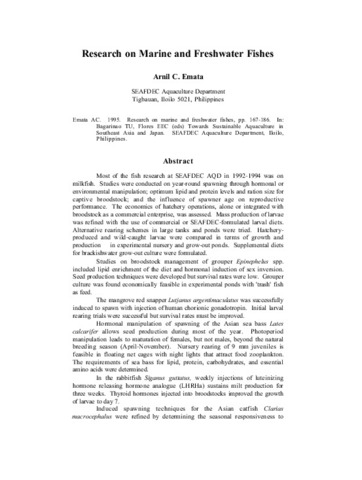The ultrastructure of the hepatocytes of the giant seaperch, Lates calcarifer (Bloch) (Pisces: Centropomidae), during starvation and refeeding with different diets.
- Global styles
- MLA
- Vancouver
- Elsevier - Harvard
- APA
- Help
View/Open
Date
1986Author
Page views
1,791ASFA keyword
AGROVOC keyword
Taxonomic term
Metadata
Show full item recordShare
Abstract
Three groups of immature seaperch acclimated in the laboratory on a mixed commercial pellet and minced trashfish diet were starved for 30 days. Thereafter, the first group was starved for 7 more days, the second was refed with commercial pellets, and the third with trashfish. Through transmission electron microscopy, it was found that after the acclimation period the hepatocytes of Lates calcarifer were primarily lipid-storing. Upon starvation, the following modifications in the hepatocytes were evident: decrease of lipid reserves, hepatocyte shrinkage, mitochondrial swelling, dilation of the cisternae of the rough endoplasmic reticulum (RER), and the presence of lysosomes. Among the refed fish, only the hepatocytes of those which were given trashfish recovered from the injury. Recovery was indicated by the restitution of the morphology of the mitochondria, development of parallel stacks of RER, increase in lipid and glycogen, and the distinct compartition of the hepatocytes.
Suggested Citation
Avila, E. M. (1986). The ultrastructure of the hepatocytes of the giant seaperch, Lates calcarifer (Bloch) (Pisces: Centropomidae), during starvation and refeeding with different diets. Asian Marine Biology , 3, 129-137. http://hdl.handle.net/10862/1174
Type
ArticleISSN
1011-4041Collections
- Journal Articles [1247]
Related items
Showing items related by title, author, creator and subject.
-
Research on marine and freshwater fishes
Emata, Arnil C. (Aquaculture Department, Southeast Asian Fisheries Development Center, 1995)Most of the fish research at SEAFDEC AQD in 1992-1994 was on milkfish. Studies were conducted on year-round spawning through hormonal or environmental manipulation; optimum lipid and protein levels and ration size for ... -
Proceedings of the Seminar-Workshop on Aquaculture Development in Southeast Asia and Prospects for Seafarming and Searanching, 19-23 August 1991, Iloilo City, Philippines
Lacanilao, F.; Coloso, Relicardo M.; Quinitio, Gerald F. (Aquaculture Department, Southeast Asian Fisheries Development Center, 1994)Documents the presentations at ADSEA '91, the 2nd Seminar-Workshop on Aquaculture Development in Southeast Asia. ADSEA '91 includes reviews of the status of the researches conducted by Southeast Asian Fisheries Development ... -
Nursery and grow-out culture of high-value fish species in sea cages
Gaitan, Albert G.; Toledo, Joebert D. (Aquaculture Department, Southeast Asian Fisheries Development Center, 2009)





